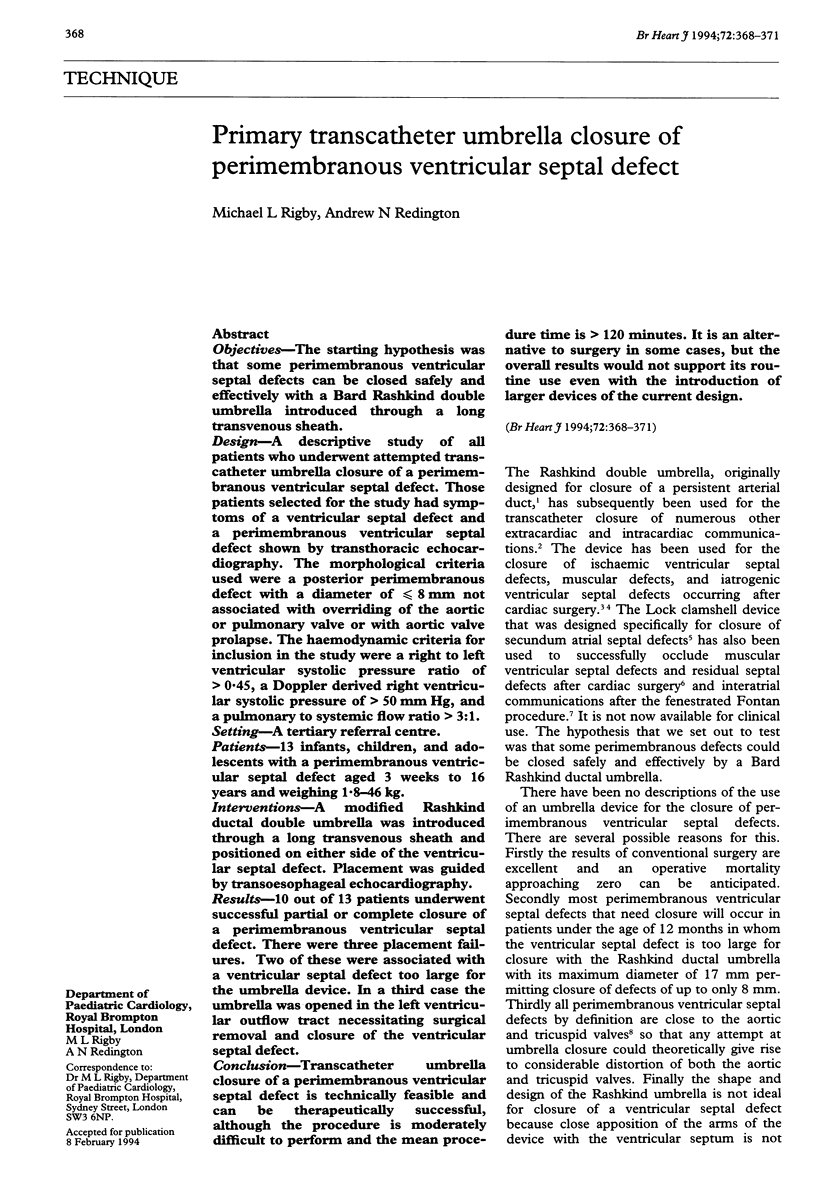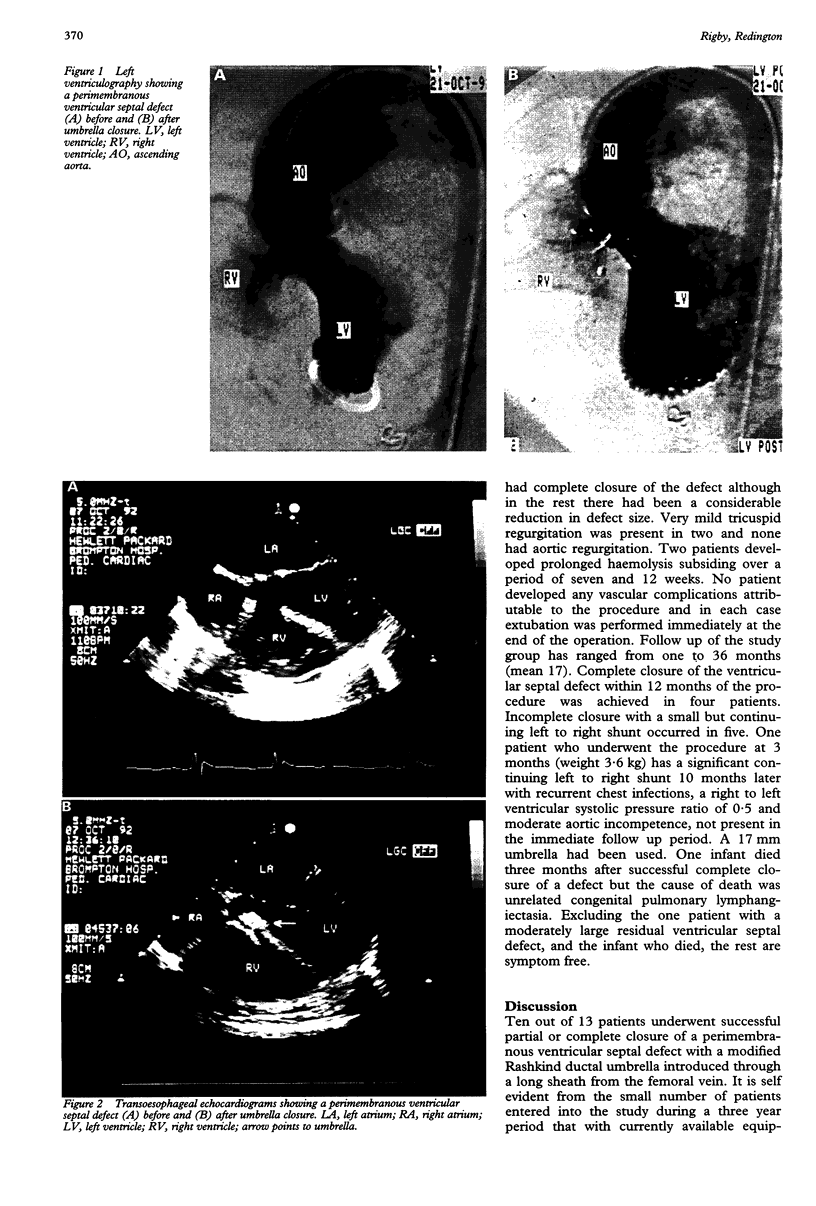Abstract
OBJECTIVES--The starting hypothesis was that some perimembranous ventricular septal defects can be closed safely and effectively with a Bard Rashkind double umbrella introduced through a long transvenous sheath. DESIGN--A descriptive study of all patients who underwent attempted transcatheter umbrella closure of a perimembranous ventricular septal defect. Those patients selected for the study had symptoms of a ventricular septal defect and a perimembranous ventricular septal defect shown by transthoracic echocardiography. The morphological criteria used were a posterior perimembranous defect with a diameter of < or = 8 mm not associated with overriding of the aortic or pulmonary valve or with aortic valve prolapse. The haemodynamic criteria for inclusion in the study were a right to left ventricular systolic pressure ratio of > 0.45, a Doppler derived right ventricular systolic pressure of > 50 mm Hg, and a pulmonary to systemic flow ratio > 3:1. SETTING--A tertiary referral centre. PATIENTS--13 infants, children, and adolescents with a perimembranous ventricular septal defect aged 3 weeks to 16 years and weighing 1.8-46 kg. INTERVENTIONS--A modified Rashkind ductal double umbrella was introduced through a long transvenous sheath and positioned on either side of the ventricular septal defect. Placement was guided by transoesophageal echocardiography. RESULTS--10 out of 13 patients underwent successful partial or complete closure of a perimembranous ventricular septal defect. There were three placement failures. Two of these were associated with a ventricular septal defect too large for the umbrella device. In a third case the umbrella was opened in the left ventricular outflow tract necessitating surgical removal and closure of the ventricular septal defect. CONCLUSION--Transcatheter umbrella closure of a perimembranous ventricular septal defect is technically feasible and can be therapeutically successful, although the procedure is moderately difficult to perform and the mean procedure time is > 120 minutes. It is an alternative to surgery in some cases, but the overall results would not support its routine use even with the introduction of larger devices of the current design.
Full text
PDF



Images in this article
Selected References
These references are in PubMed. This may not be the complete list of references from this article.
- Bridges N. D., Lock J. E., Castaneda A. R. Baffle fenestration with subsequent transcatheter closure. Modification of the Fontan operation for patients at increased risk. Circulation. 1990 Nov;82(5):1681–1689. doi: 10.1161/01.cir.82.5.1681. [DOI] [PubMed] [Google Scholar]
- Bridges N. D., Perry S. B., Keane J. F., Goldstein S. A., Mandell V., Mayer J. E., Jr, Jonas R. A., Casteneda A. R., Lock J. E. Preoperative transcatheter closure of congenital muscular ventricular septal defects. N Engl J Med. 1991 May 9;324(19):1312–1317. doi: 10.1056/NEJM199105093241903. [DOI] [PubMed] [Google Scholar]
- Lock J. E., Block P. C., McKay R. G., Baim D. S., Keane J. F. Transcatheter closure of ventricular septal defects. Circulation. 1988 Aug;78(2):361–368. doi: 10.1161/01.cir.78.2.361. [DOI] [PubMed] [Google Scholar]
- O'Laughlin M. P., Mullins C. E. Transcatheter occlusion of ventricular septal defect. Cathet Cardiovasc Diagn. 1989 Jul;17(3):175–179. doi: 10.1002/ccd.1810170311. [DOI] [PubMed] [Google Scholar]
- Perry S. B., Lock J. E. Front-loading of double-umbrella devices, a new technique for umbrella delivery for closing cardiovascular defects. Am J Cardiol. 1992 Oct 1;70(9):917–920. doi: 10.1016/0002-9149(92)90738-k. [DOI] [PubMed] [Google Scholar]
- Rashkind W. J., Mullins C. E., Hellenbrand W. E., Tait M. A. Nonsurgical closure of patent ductus arteriosus: clinical application of the Rashkind PDA Occluder System. Circulation. 1987 Mar;75(3):583–592. doi: 10.1161/01.cir.75.3.583. [DOI] [PubMed] [Google Scholar]
- Redington A. N., Rigby M. L. Novel uses of the Rashkind ductal umbrella in adults and children with congenital heart disease. Br Heart J. 1993 Jan;69(1):47–51. doi: 10.1136/hrt.69.1.47. [DOI] [PMC free article] [PubMed] [Google Scholar]
- Rome J. J., Keane J. F., Perry S. B., Spevak P. J., Lock J. E. Double-umbrella closure of atrial defects. Initial clinical applications. Circulation. 1990 Sep;82(3):751–758. doi: 10.1161/01.cir.82.3.751. [DOI] [PubMed] [Google Scholar]
- Soto B., Becker A. E., Moulaert A. J., Lie J. T., Anderson R. H. Classification of ventricular septal defects. Br Heart J. 1980 Mar;43(3):332–343. doi: 10.1136/hrt.43.3.332. [DOI] [PMC free article] [PubMed] [Google Scholar]




